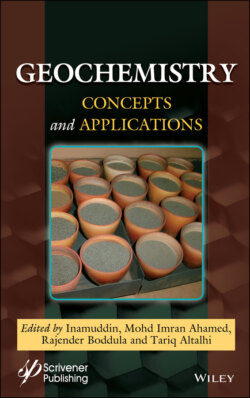Читать книгу Geochemistry - Группа авторов - Страница 12
1.2.2.2 Toxic Metals
ОглавлениеSerpentinitic geological systems contain extremely high concentrations of toxic metals, specifically Fe, Ni, Cr, Co, Mn, and Zn [4, 27, 28]. The total concentrations of toxic metals have been reported to be in the order of hundreds and thousands mg per kg of dry soil. For example, the following total concentration of toxic metals was reported in serpentinitic geological systems in Albania: 3,865 mg Cr/kg, 3,579 mg Ni/kg, 2,495 mg Zn/kg, 1,107 mg Cu/kg, and 476 mg Co/kg [26]. High concentrations of toxic metals were also reported elsewhere in India and Zimbabwe [27]. Two points are noteworthy literature on toxic metals: (1) high total concentrations of Cr and Ni are considered universal in serpentines, but they co-occur with other toxic metals (e.g., Zn, Fe, and Mn) in equally high concentrations, and (2) the bulk of the data on toxic metals report total concentrations, which indicate the total pool in the soil, but provide no indication on the bioavailable and bioaccessible fractions [4]. The lack of data on bioavailable and bioaccessible concentrations makes it difficult to infer human health risks from such data. In some instances (e.g., Cr), some metal species (e.g., Cr (VI)) are more toxic than others (e.g., Cr(III)), but data on speciation are rarely provided in most studies on toxic metals.
The literature on metal geochemistry in serpentinitic geological environments is dominated by Cr, particularly Cr(VI), probably due to its high toxicity [4, 29]. Specifically, several studies exist on the role of Mn minerals (e.g., MnO2, birnessite,) in accelerating the dissolution of Cr-bearing spinels such as chromite (FeCr2O4) and magnesiochromite (MgCr2O4), and the oxidation of Cr(III) to Cr(VI) [1, 30]. The accelerated dissolution and oxidation account for extremely high concentrations of Cr(VI) detected in aquatic ecosystem in serpentinitic geological systems [9, 29]. For instance, a recent review showed that high Cr(VI) concentrations above the World Health Organization (WHO) limit for drinking water (i.e., 50 μg L−1 equivalent to 960 nM Cr(VI)) have been detected in both surface water and groundwater in several countries [4]. Such high concentrations may pose significant human health risks in cases where communities rely on untreated drinking water.
Unlike chrysotile, toxic metals may undergo uptake and bioaccumulation by wild plants and food crops. Rhizospheric processes including, root-soil interactions and the release of root exudates are critical in the biogeochemical behavior of toxic metals [4, 31]. For instance, root-soil interactions and root exudates may increase the bioavailability and bioaccesibility of toxic metals, and their subsequent uptake and bioaccumulation by plants and crops [31]. Such processes may transfer toxic metals from the soil system into the human food chain, thereby posing human health risks.
